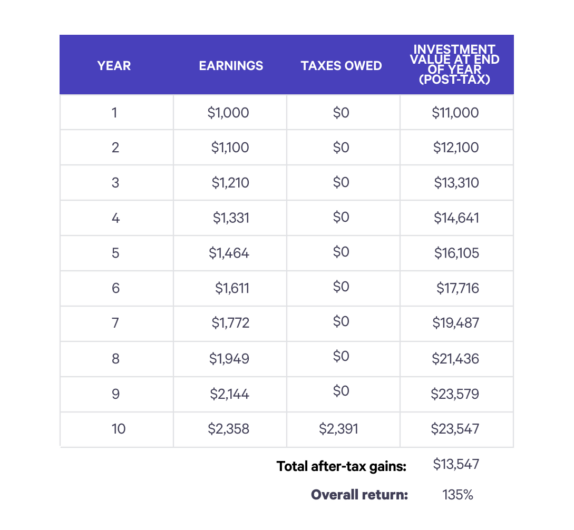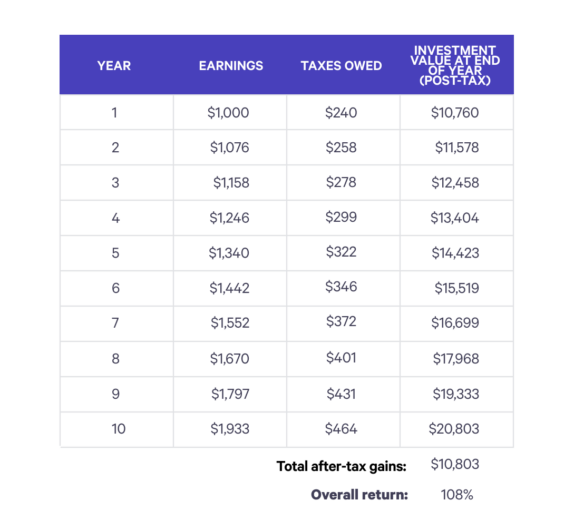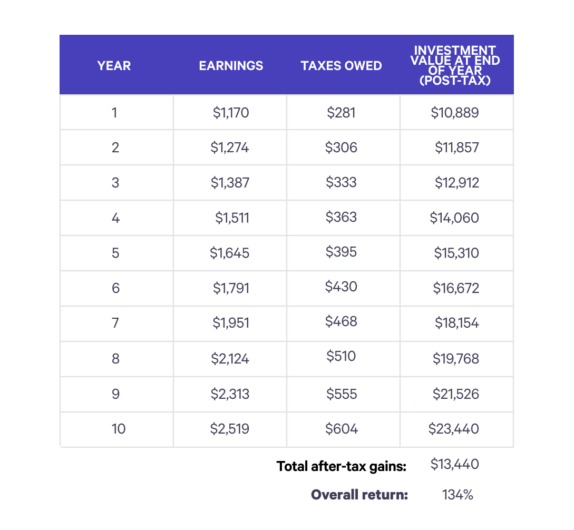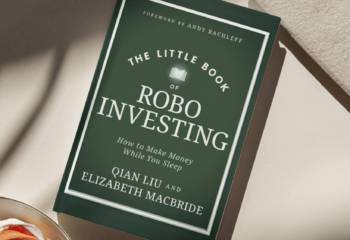Day trading may be popular right now, but that doesn’t mean it’s a good idea. In a recent blog post, we explained why investors and traders shouldn’t be fooled by absolute returns and that earning seemingly strong returns of 30% when the market is up 50% is actually pretty terrible performance. Once you consider taxes, that disparity can grow even larger. In fact, compounded over 10 years, average annual returns of 11.7% can still underperform market returns of 10%. Let’s take a look at why.
It’s all about capital gains
Many of you already know that long-term capital gains are taxed at a much lower rate than short-term capital gains. As a result, you can lower your taxes just by holding onto investments for at least a year. The average federal long-term rate in 2019 was 15%, compared to 24% for short-term gains. That’s a big difference, and it compounds over time.
Equally important to how much you pay in taxes is when you pay them. You only pay capital gains taxes when your gain is realized (that’s when you sell the stock, ETF, fund, etc). If you trade frequently, this means you can end up paying short-term capital gains every single year. On the other hand, if you buy and hold for 10 years, you pay long-term capital gains just once when you sell. That timing is critical because it means the money you haven’t paid in taxes every year has been in your account compounding instead.
We’ve written about compounding interest before and won’t get into all of the details here. But it’s important to understand that the longer your money is invested, the faster it grows. And every time you pay taxes, the money you pay to the government is money that does not compound.
Doing the math
Tax rates and compounding interest can feel complicated and abstract, so let’s look at some concrete examples that demonstrate how this works. Below, we’ve outlined three scenarios. In each case, we look at a hypothetical investment of $10,000, investigating how it grows and is impacted by taxes over 10 years. To simplify all three examples, we’ll ignore the impact of fees. We’ll also assume you don’t make any additional deposits or withdrawals except for tax purposes.
Scenario 1: Buy and hold an index fund that tracks the market
In this first example, we’ll assume you invest $10,000 in an index fund that tracks the market and you hold that investment for 10 years. To keep the math simple, we’ll assume you earned an annual return of 10%. At the end of the 10 years, we’ll assume you owe the average 15% capital gains tax on your gain. As the table below shows, your overall after-tax return would be 135%.

Scenario 2: Day trading that matches market performance
In this example, we’ll assume you made the same $10,000 initial investment and (against all odds) were able to match the market’s 10% annual returns from scenario 1. However, we’ll assume you did a lot of trading to get there and as a result, you owe taxes on your gains at the end of every year. And because you held your investments for a shorter period of time, we’ll assume you owed the average short-term capital gains rate on them, which translates to a much higher tax rate of 24%.

As you can see, taxes have eaten into your total return in a big way. Even though you earned the same 10% annual return, your overall return is only 108%, compared to 135% when you just bought and held an index fund.
Scenario 3: Day trading that beats the market
In this final example, we’ll use the same assumptions from scenario 2 with just one change: we’ll imagine that you somehow beat the market and generate 11.7% returns each year.

It turns out that even if you generate an 11.7% annual return, you still would have been better off buying and holding that index fund after accounting for taxes.
In fact, the larger the market returns, the more a day trader needs to outperform the market just to keep up after taxes. Since 2010, the S&P 500 has averaged annual returns of 13.6%. To beat that return with a 24% tax rate factored in, day trading returns would need to be more than 16.2% annually. It’s extremely unlikely that any investor, even a professional, could match market returns over 10 years, much less outperform the market to this extent.
Don’t bother day trading
In general, day trading is a futile effort. You’re very unlikely to generate high returns relative to the market, and even if you do, taxes will destroy a big chunk of your gains. That’s why investment services like Wealthfront provide so much value. Not only is our approach to long-term passive investing time-tested and academically proven, but we also work to lower your tax bill with services like Tax-Loss Harvesting, so you’re left with more to invest.
Next time you’re tempted to take up day-trading, don’t forget about the tax consequences. Remember that beating the market before taxes doesn’t always translate to higher total returns.
Disclosure
The information contained in this communication is provided for general informational purposes only, and should not be construed as investment or tax advice. Nothing in this communication should be construed as a solicitation, offer, or recommendation, to buy or sell any security. Any links provided to other server sites are offered as a matter of convenience and are not intended to imply that Wealthfront Advisers or its affiliates endorses, sponsors, promotes and/or is affiliated with the owners of or participants in those sites, or endorses any information contained on those sites, unless expressly stated otherwise.
Wealthfront Advisers and its affiliates do not provide legal or tax advice and do not assume any liability for the tax consequences of any client transaction. Clients should consult with their personal tax advisors regarding the tax consequences of investing with Wealthfront Advisers and engaging in these tax strategies, based on their particular circumstances. Clients and their personal tax advisors are responsible for how the transactions conducted in an account are reported to the IRS or any other taxing authority on the investor’s personal tax returns. Wealthfront Advisers assumes no responsibility for the tax consequences to any investor of any transaction.
The effectiveness of the tax-loss harvesting strategy to reduce the tax liability of the client will depend on the client’s entire tax and investment profile, including purchases and dispositions in a client’s (or client’s spouse’s) accounts outside of Wealthfront Advisers and type of investments (e.g., taxable or nontaxable) or holding period (e.g., short- term or long-term).
Wealthfront Advisers’ investment strategies, including portfolio rebalancing and tax loss harvesting, can lead to high levels of trading. High levels of trading could result in (a) bid-ask spread expense; (b) trade executions that may occur at prices beyond the bid ask spread (if quantity demanded exceeds quantity available at the bid or ask); (c) trading that may adversely move prices, such that subsequent transactions occur at worse prices; (d) trading that may disqualify some dividends from qualified dividend treatment; (e) unfulfilled orders or portfolio drift, in the event that markets are disorderly or trading halts altogether; and (f) unforeseen trading errors. The performance of the new securities purchased through the tax-loss harvesting service may be better or worse than the performance of the securities that are sold for tax-loss harvesting purposes.
Tax loss harvesting may generate a higher number of trades due to attempts to capture losses. There is a chance that trading attributed to tax loss harvesting may create capital gains and wash sales and could be subject to higher transaction costs and market impacts. In addition, tax loss harvesting strategies may produce losses, which may not be offset by sufficient gains in the account and may be limited to a $3,000 deduction against income. The utilization of losses harvested through the strategy will depend upon the recognition of capital gains in the same or a future tax period, and in addition may be subject to limitations under applicable tax laws, e.g., if there are insufficient realized gains in the tax period, the use of harvested losses may be limited to a $3,000 deduction against income and distributions. Losses harvested through the strategy that are not utilized in the tax period when recognized (e.g., because of insufficient capital gains and/or significant capital loss carryforwards), generally may be carried forward to offset future capital gains, if any.
Investment advisory services are provided by Wealthfront Advisers, an SEC-registered investment adviser, and brokerage products and services are provided by Wealthfront Brokerage LLC, member FINRA / SIPC. Wealthfront Software LLC (“Wealthfront”) offers a free software-based financial advice engine that delivers automated financial planning tools to help users achieve better outcomes.
All investing involves risk, including the possible loss of money you invest, and past performance does not guarantee future performance. Please see our Full Disclosure for important details.
Wealthfront Advisers, Wealthfront Brokerage and Wealthfront are wholly owned subsidiaries of Wealthfront Corporation.
© 2020 Wealthfront Corporation. All rights reserved.
About the author(s)
The Wealthfront Team believes everyone deserves access to sophisticated financial advice. The team includes Certified Financial Planners (CFPs), Chartered Financial Analysts (CFAs), a Certified Public Accountant (CPA), and individuals with Series 7 and Series 66 registrations from FINRA. Collectively, the Wealthfront Team has decades of experience helping people build secure and rewarding financial lives. View all posts by The Wealthfront Team



